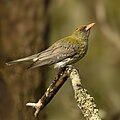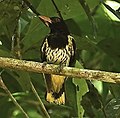| Image | Common name | Scientific name | Distribution |
|---|
| Brown oriole | Oriolus szalayi | New Guinea |
| Dusky-brown oriole | Oriolus phaeochromus | North Maluku |
| Grey-collared oriole | Oriolus forsteni | Seram |
| Black-eared oriole | Oriolus bouroensis | Buru Island |
| Tanimbar oriole | Oriolus decipiens | Tanimbar Islands |
| Timor oriole | Oriolus melanotis | Timor, Rote and Semau Islands |
| Wetar oriole | Oriolus finschi | Wetar and Atauro Islands |
 | Olive-backed oriole | Oriolus sagittatus | eastern Australia and south-central New Guinea. |
 | Green oriole | Oriolus flavocinctus | Australia and New Guinea |
 | Dark-throated oriole | Oriolus xanthonotus | Southeast Asia through Malay Peninsula, Sumatra, Bangka, Java and southwestern Borneo |
| Ventriloquial oriole | Oriolus consobrinus | Borneo and the Philippines |
| Philippine oriole | Oriolus steerii | the Philippines |
| White-lored oriole | Oriolus albiloris | Luzon Island (the Philippines) |
| Isabela oriole | Oriolus isabellae | Luzon |
 | Eurasian golden oriole | Oriolus oriolus | Europe and western Asia, and spends the winter season in central and southern Africa |
 | Indian golden oriole | Oriolus kundoo | Indian subcontinent and Central Asia |
 | African golden oriole | Oriolus auratus | Africa south of the Sahara desert |
 | Slender-billed oriole | Oriolus tenuirostris | eastern Himalayas to Southeast Asia |
 | Black-naped oriole | Oriolus chinensis | eastern Siberia, Ussuriland, northeastern China, Korea and northern Vietnam |
 | Green-headed oriole | Oriolus chlorocephalus | eastern Africa |
| São Tomé oriole | Oriolus crassirostris | island of São Tomé |
 | Western oriole | Oriolus brachyrynchus | African tropical rainforest |
| Ethiopian oriole | Oriolus monacha | north-eastern Africa |
| Mountain oriole | Oriolus percivali | Albertine Rift montane forests, Uganda and Kenya |
 | Black-headed oriole | Oriolus larvatus | Africa |
| Black-winged oriole | Oriolus nigripennis | African tropical rainforest |
 | Black-hooded oriole | Oriolus xanthornus | tropical southern Asia from India and Sri Lanka east to Indonesia |
| Black oriole | Oriolus hosii | Sarawak in Borneo |
 | Black-and-crimson oriole | Oriolus consanguineus | Indonesia and Malaysia |
| Javan oriole | Oriolus cruentus | Indonesia |
 | Maroon oriole | Oriolus traillii | Southeast Asia |
 | Silver oriole | Oriolus mellianus | southern China and winters in mainland Southeast Asia |
|























